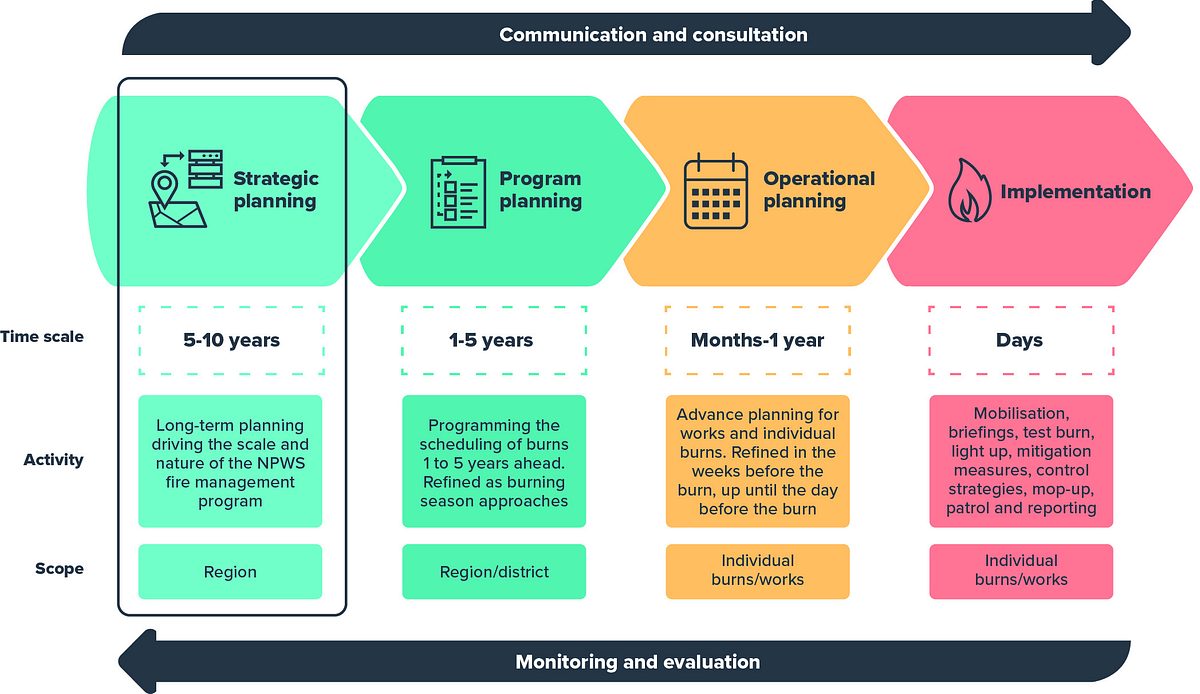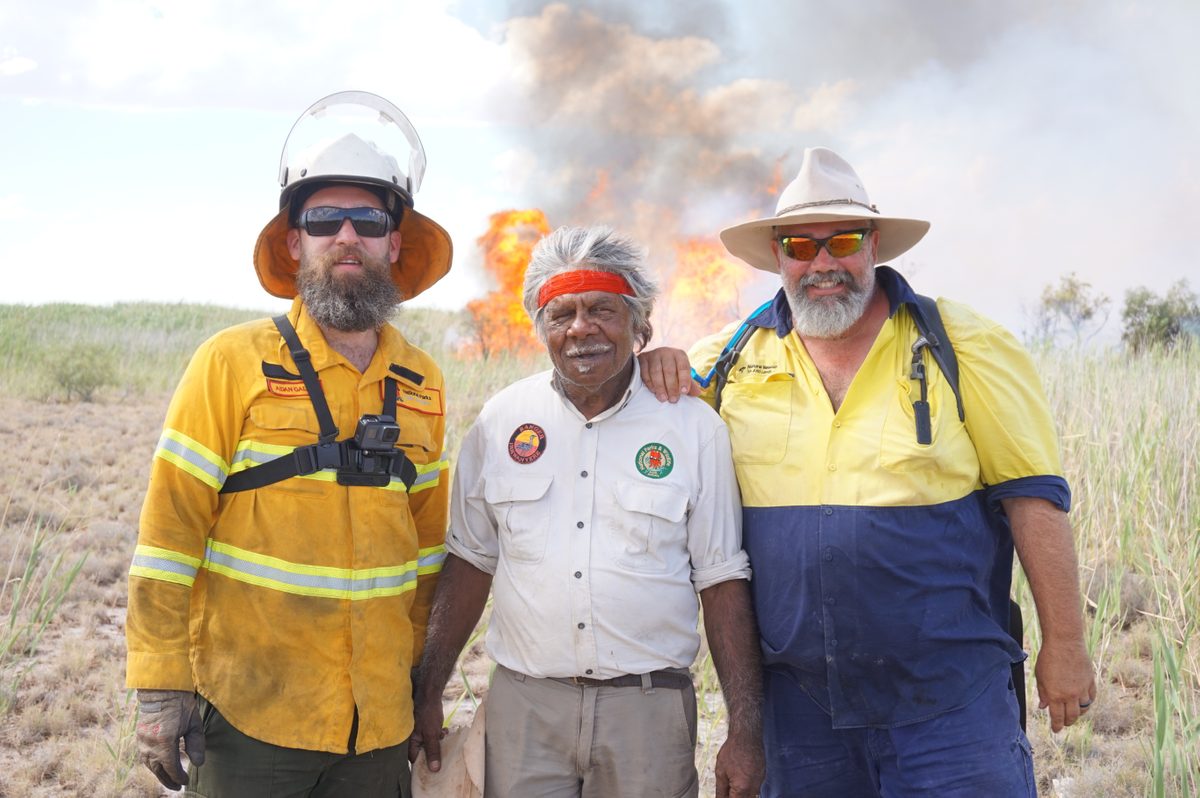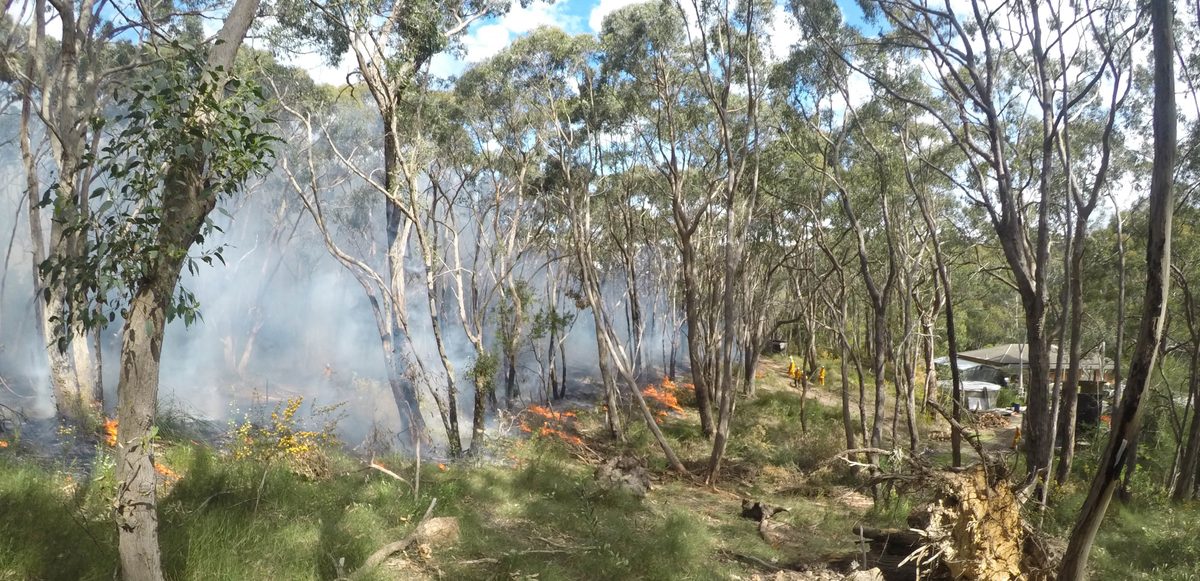Fire management planning in SA parks
Head here for the latest:
Fire management plans help guide fire management activities in South Australian parks and on crown land.
They set strategic priorities about where, how, and why we need to undertake risk reduction activities to reduce the risk of bushfire and manage the environment. For example, the ecological process of fire is critical to helping many native plants and animal habitats to regenerate, and it can help with weed control. They are informed by the latest technology, evidence and science available.
What is a bushfire? A bushfire is an unplanned vegetation fire which includes grass, forest and scrub fires. Bushfires are a natural, essential and complex part of the Australian environment and have been for thousands of years. However, bushfires can significantly impact on lives, property and the environment. Source: Australian Institute for Disaster Resilience
The fire management planning process considers:
- bushfire risk to park assets including the natural, built and heritage values these parks are protecting
- fire regimes required to maintain and enhance biodiversity
- management strategies that address highest priority areas first to lessen the risk and minimise negative impacts
- and is informed by monitoring and evaluation requirements.
Achieving balanced fire management outcomes for human life, property, environment and cultural assets can be complex. National and state policies place priority on the protection of human life (i.e. safety for firefighters and the community). NPWS fire management seeks to achieve environmental objectives consistent with the protection of human life but where these values conflict, human life is prioritised. However, as part of our overarching commitment to environmental outcomes, NPWS is dedicated to ensuring that fire management strategies strive to maximise positive environmental outcomes as far as possible.
While fire management focuses on public land, it also helps reduce bushfire risk to neighbouring properties and to ecosystems that continue beyond park boundaries.
Fire management plans provide the long-term strategic vision to help guide the development of 1 to 5-year program plans, annual operational plans and activities on the day. See this example with prescribed burns, from planning to implementation.

Actions from these plans include:
- modifying fuel through mechanical means – rolling, lopping, chipping, crushing, piling and slashing vegetation to lessen risk
- prescribed burning – using the right kind of fire in the right place at the right time, and applied in the right way to reduce fuel in an environmentally sensitive way
- constructing, re-aligning, upgrading and/or maintaining tracks for firefighters
- constructing and maintaining fire management infrastructure including water supply points, access gates and signs.
A fire management plan can’t prevent bushfire events, but it can focus NPWS fire management actions on strategies to reduce bushfire impacts and improve firefighter response. Likewise, prescribed burns won’t stop all bushfires, but they may limit their spread and impact, and make them easier and safer to suppress.
Planning and being prepared for a bushfire is a shared responsibility and everyone has a role to play. CFS delivers programs for communities in high bushfire risk areas and has resources to help individuals, communities and organisations understand their role in bushfire preparedness and planning.
Guiding documents for NPWS fire management planning
Bushfire planning and fire management is guided by policies, plans and guidelines including:
- Department for Environment and Water (DEW) internal policy and procedures
- Bushfire management areas plans (State Bushfire Coordination Committee)
- Reserve management plans (NPWS)
- Fire management zone standard guidance for use (State Bushfire Coordination Committee)
- SA firebreak, fire access track and sign standards guidelines (State Bushfire Coordination Committee)
- National bushfire management policy statement for forests and rangelands(Forest Fire Management Group).
Under the Fire and Emergency Services Act 2005, the Department for Environment and Water (DEW), of which NPWS is a part of, has a responsibility to prevent or inhibit the risk of outbreak or spread of bushfire, protect property, and minimise the threat to human life from fire in SA parks and on crown land.
Fire management plans, although not statutory documents, help NPWS plan and implement strategies to meet its responsibilities under this legislation. Other pieces of state and federal legislation also influence this planning.

When NPWS develops a fire management plan it works with a range of key stakeholders to incorporate their knowledge and experience into the plan. This includes (but is not limited to):
| SA Country Fire Service staff and volunteers | Ecologists and researchers | DEW science and information staff |
| NPWS staff | Bureau of Meteorology | Landscape boards |
| First Nations groups | Environmental groups | Friends of Parks groups |
| Bushfire management committees | Local councils | Local landholders |
| Industry groups | Individuals | Community groups |
Once a draft fire management plan is developed, it is released for public consultation via YourSAy for a minimum of 6 weeks. This consultation allows interested people to view the draft plan and provide feedback, which is considered by NPWS when finalising the plan.
Sign up to our FireSide e-news and we’ll let you know when draft fire management plans are released for public consultation.
The NPWS Fire Management Program works with bushfire researchers and other organisations to further our knowledge and improve the way fire management activities are planned and implemented. Research projects range from examining the effects of changing fire regimes (i.e. the timing, frequency and intensity of fire) on plant and animal communities to the development of fire behaviour models for various vegetation communities. Find out more about our fire research.

Bushfire risk combines the likelihood of a fire starting and spreading with the consequence to those things we value such as human life, property, infrastructure and the environment. This risk is influenced by 3 key factors:
- Hazard: the weather conditions, the fuel available to burn and the topography of the location combine to determine how the fire will behave.
- Ignition: where the fire starts will influence how quickly people can report it and if it is easy to access.
- Values: the location of what we care about, to that fire.
Climate change impacts on bushfires
Bushfires are a natural part of the Australian landscape and have shaped its ecosystems for thousands of years. In fact Australia is the most fire-prone continent on Earth with south-eastern Australia at risk of large bushfires. Research suggests that this risk is compounded by the effects of climate change. According to the latest data Australian land areas have warmed approximately 1.5 degrees Celsius over the past century. Rainfall has also declined over much of South Australia since the 1970s. Find out more on how climate change is affecting South Australia.
The impacts climate change may have on fire management include an increase in the intensity of bushfires and incidence of extreme and catastrophic fire danger days, which will potentially lead to longer fire danger seasons and may reduce the time available for reducing bushfire risk through prescribed burning.
A bushfire risk assessment considers how bushfire might impact on what we value; human life, property, infrastructure and the environment. The planning team completes a risk assessment using the best available global, national and local science, data and knowledge and incorporates this into computer models. Combined with expert knowledge the team then assigns strategies to reduce this risk to those things we value. Risks are assessed at the landscape and local scale with priority given to those values most at risk.
Computer models help us analyse complex scenarios and view the effect of different strategies, so we can choose the most effective one. The models, datasets and tools used by NPWS simulate bushfire scenarios, calculate risk, and test strategies.
All this information is put into an internal GIS-based tool called fire landscape assessment and risk evaluation (FLARE). FLARE displays the outputs in the one place. We use it to help us test competing fire management objectives across the landscape and work out the best strategies based on the bushfire risks and/or biodiversity needs in a particular location.
Landscape risk
Assessing bushfire risk to large areas is done using a simulation model called Phoenix RapidFire. This model shows us how a bushfire can spread from where a fire started using various scenarios such as the terrain, fuel and weather conditions.
How easy the fire will be to put out is assessed by calculating the distance from a fire station, road type (bitumen, gravel, winding, straight) etc.
Phoenix RapidFire also simulates thousands of fires across the landscape with current and future vegetation loads to predict how bushfires spread from ignition points. By running simulated fires across an area, we identify possible ignitions that can cause the largest fires and/or impact the most values.
Human life and property risk
NPWS collaborates with CFS to assess bushfire risk to human life and property on lands we manage using the Bushfire Risk Information Management System.
Our policies reduce the likelihood of people visiting the lands we manage should a bushfire occur, with some built assets able to provide some level of protection from radiant heat and flames. Risk assessments on NPWS property includes buildings such as visitor centres, sheds and storage facilities, water tanks, roads and tracks, including built heritage reflecting a maritime or colonial/agricultural history.
Based on these risks, NPWS assesses the most appropriate strategy on land we manage. Our risk assessments are also included in the State Bushfire Coordination Committee's bushfire management area plans.
Environmental risk
An environmental risk assessment identifies native plant and animal habitats, including threatened species and ecological communities, watercourses, and wetlands. Habitats likely to receive a significant degree of damage from bushfire are prioritised for strategies.
We work out strategies to achieve suitable fire regimes for plants and animals using the Dynamic Fire and Biodiversity (DFaB) model and ecological fire management guidelines and strategies. The DFaB model uses fire history data, with fire-dependent, threatened animal species’ habitat requirements, to identify where to focus prescribed burns to maintain optimal habitat. The results are used alongside other objectives (e.g. protect human life and property) to create the best solution.
Find out more on how environmental impacts are assessed before and after fire management activities.
First Nations Cultural risk
NPWS engages with First Nations to develop fire management plans which help identify First Nations sites on parks which may be vulnerable to bushfire and require protection. NPWS is committed to working with, and learning from, First Nations to manage fire in the landscape.

A fire management strategy is an activity (e.g. prescribed burn, slashing or thinning vegetation), piece of infrastructure (e.g. fire access track, water tank), or policy (e.g. temporary park closure) which helps reduce bushfire risk, support firefighting efforts, or protect environmental values.
Fire management strategies can be made up of a combination of actions to:
- reduce fuel hazards
- provide reliable fire infrastructure such as water and access to fires via track networks and airstrips
- reduce the likelihood of NPWS staff and visitors being in areas of bushfire risk through policies that alter access to parks
- increase NPWS staff, visitors and community knowledge and awareness of bushfire risks and enhance their capacity to prepare for bushfires
- use fire as a tool to maintain and enhance natural values.
Managing fuel hazards
Fuel hazards include living and dead vegetation that influences the speed and intensity of a bushfire. By modifying these hazards we aim to create the conditions to better control bushfires when and where they occur, to protect what we all value
How much fuel is modified, and how it is done, is determined by the fire management zone assigned to a location during fire management planning - as described below.
There are 3 main methods used to reduce bushfire fuel, which suit different situations: mechanical removal of vegetation (such as slashing), chemical knockdown (such as weed spraying), and prescribed burns.
Fire management zones
The South Australian State Bushfire Coordination Committee’s (SBCC) Fire management zone standard and guidance for use details zone types and how they’re used. They are:
Asset protection zone - actively managed fuel-reduced area that is alongside assets, to minimise risks to human life, property, infrastructure and environmental assets. This zone aims to stop the spread of fire and prevent direct flame contact and intense radiant heat and reduce short-distance ember attack from the immediate environment.
Bushfire buffer zone - maintained to not exceed ‘high’ overall fuel hazard levels, as an average. The aim is to minimise risks to human life, property, infrastructure and environmental assets by slowing a fire’s rate of spread, reducing its intensity, and minimising fire spotting potential over short to medium distances.
Strategicfuel management zone - the primary objective is to reduce bushfire risk to human life, property, infrastructure and the environment. Typically, only portions of the zone are treated, not the entire area.
Conservation zone - where native ecosystems are managed with ecological burns, to help conserve them.
Exclusion zone - has nominated times to exclude planned burning, usually to protect environmental values.
Fire infrastructure
To support bushfire suppression and firefighter safety, NPWS maintains fire infrastructure on the land we manage, such as:
- tracks, trails, access gates and signs following SBCC’s South Australian firebreak, fire access track and sign standards guidelines
- water supply points, fire protection systems such as sprinklers, and airstrips.
The risk assessment determines the type and location of fire infrastructure required.
Policies to reduce risk to park staff and visitors
SA parks received over 220,000 visitor bookings between January and June 2021 with many visiting during the summer holiday period when the risk of bushfires increases. Department policies and procedures reduce the risk of bushfires in parks impacting on NPWS staff and visitors by reducing the likelihood of visitors and staff being on lands we manage during days of heightened fire danger.
NPWS staff, visitor, and community education
Community engagement strategies (e.g. awareness campaigns and education programs) increase staff, visitor and community knowledge of bushfire risks and enhance their capacity to prepare for bushfires. Parks SA provides information for visitors on fire danger seasons, fires and closures. Many parks also have bushfire risk information on signage or in brochures.
Maintain and enhance natural values
Fire plays an important role in some natural processes such as stimulating seed germination. Fire, used as a tool, helps native plants establish, improve habitat for animals and for weed control. Our planning includes using strategies and guidelines for native species that need fire. To maintain and enhance biodiversity, the guidelines provide advice on the interval, frequency, size, intensity and season of a fire including use of the appropriate fire management zone as described above; conservation or exclusion.

Fire management strategies displayed in each fire management plan are also available to view as interactive maps on Nature Maps and Fire Management Maps.


